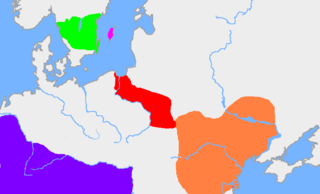
The Goths were a Germanic people who played a major role in the fall of the Western Roman Empire and the emergence of Medieval Europe.

Jordanes, also written as Jordanis or Jornandes, was a 6th-century Eastern Roman bureaucrat widely believed to be of Gothic descent who became a historian later in life. Late in life he wrote two works, one on Roman history and the other on the Goths. The latter, along with Isidore of Seville’s Historia Gothorum, is one of only two extant ancient works dealing with the early history of the Goths.

The Ostrogoths were a Roman-era Germanic people. In the 5th century, they followed the Visigoths in creating one of the two great Gothic kingdoms within the Roman Empire, based upon the large Gothic populations who had settled in the Balkans in the 4th century, having crossed the Lower Danube. While the Visigoths had formed under the leadership of Alaric I, the new Ostrogothic political entity which came to rule Italy was formed in the Balkans under the influence of the Amal Dynasty, the family of Theodoric the Great.

The Rugii, Rogi or Rugians were a Roman-era Germanic people.

The Gepids were an East Germanic tribe who lived in the area of modern Romania, Hungary and Serbia, roughly between the Tisza, Sava and Carpathian mountains. They were closely related to, or a subdivision of, the Goths.

De origine actibusque Getarum, commonly abbreviated Getica, written in Late Latin by Jordanes in or shortly after 551 AD, claims to be a summary of a voluminous account by Cassiodorus of the origin and history of the Gothic people, which is now lost. However, the extent to which Jordanes actually used the work of Cassiodorus is unknown. It is significant as the only remaining contemporaneous resource that gives the full story of the origin and history of the Goths.

Johannes Magnus was the last functioning Catholic Archbishop in Sweden, and also a theologian, genealogist, and historian.

Oium was a name for Scythia, or a fertile part of it, roughly in modern Ukraine, where the Goths, under a legendary King Filimer, settled after leaving Gothiscandza, according to the Getica by Jordanes, written around 551.

Filimer was an early Gothic king, according to Jordanes. He was the son of Gadareiks and the fifth generation since Berig settled with his people in Gothiscandza. When the Gothic nation had multiplied Filimer decided to move his people to Scythia where they defeated the Sarmatians. They then named their new territory Oium, meaning "in the waterlands". This migration would have allegedly taken place about 2030 years before Jordanes wrote his "Origin of the Goths".
The Amali – also called Amals, Amalings or Amalungs – were a leading dynasty of the Goths, a Germanic people who confronted the Roman Empire during the decline of the Western Roman Empire. They eventually became the royal house of the Ostrogoths and founded the Ostrogothic Kingdom of Italy.
The "Ballad of Eric" is a ballad found in Latin and Swedish about the legendary Gothic king Erik. It was once seen as a valuable source for Migration Period history, but is now regarded as an inauthentic piece of fakelore created during the 16th century.
The Gutones were a Germanic people who were reported by Roman era writers in the 1st and 2nd centuries to have lived in what is now Poland. The most accurate description of their location, by the geographer Ptolemy, placed them east of the Vistula river.
The Romana is a Latin book written by Jordanes in the 6th century, being a short compendium of the most remarkable events from the creation down to the victory obtained by Narses, in AD 552, over king Teia. The work has been published under many different titles: De Regnorum ac Temporum Successione, Liber de origine mundi et actibus Romanorum ceterarumque gentium or De gestis Romanorum.
The belagines were written laws which, according to Jordanes, were given to the Goths by Dicineus / Dekaineos, the Dacian-Getic legislator, Zalmoxian priest at the time of Burebista.

The Historia de omnibus Gothorum Sueonumque regibus is a posthumously published, partly pseudo-historical work by Johannes Magnus, Sweden's last Catholic archbishop. In 1554 it was published in Latin by his brother Olaus Magnus.
Ablabius is thought to be either an historian, a geographer or ethnographer, who had written about the Goths, and whose work is cited by the influential 6th.century historian of the Goths, Jordanes. Since Jordanes himself states that he based his own work on recollections of reading a work on Gothic history, now lost, composed by Cassiodorus, Ablabius has traditionally been thought of as a source also for the latter work, though this view has met with considerable scepticism.
Vinitharius (Vinithar) was possibly a king of the Greuthungian Goths around 375-376 AD. Vinitharius is mentioned by Gothic historian Jordanes in Getica. According to him Vinitharius became the new king of the Greuthungi after the death of Ermanaric (Hermanaric). Ammianus Marcellinus reports that Ermanaric was succeeded by Vithimiris.
In medieval studies, an origo gentis is the origin story of a gens (people). It is not a literary genre of its own, but it is a part of quite extensive works that describe, for example, the history of the respective people. They can also be part of hero epics or biographies.
Arne Søby Christensen is a Danish historian. He is an associate professor in history at the University of Copenhagen.
There were several origin stories of the Gothic peoples recorded by Latin and Greek authors in late antiquity, and these are relevant not only to the study of literature, but also by historians seeking evidence of real historical events involving the Goths and other peoples mentioned in these stories.









